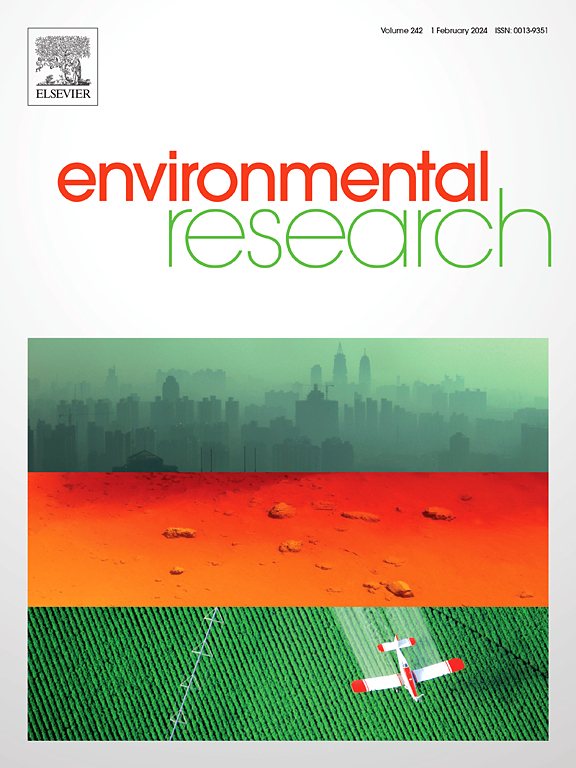一种健康:亚慢性暴露于低环境硫化氢会增加小鼠甲型流感病毒感染的死亡率。
IF 7.7
2区 环境科学与生态学
Q1 ENVIRONMENTAL SCIENCES
引用次数: 0
摘要
环境在调节呼吸道感染的易感性和严重程度方面起着重要作用。流感是全球一种重要的人畜共患疾病。硫化氢(H2S)是一种刺激呼吸道的有毒气体,在环境中无处不在。环境H2S暴露与流感的相互作用尚不清楚。在这项初步研究中,我们验证了亚慢性暴露于环境H2S会加重小鼠甲型流感病毒(IAV)感染结果的假设。将雄性C57BL6小鼠暴露于室内空气(RA)或5或10 ppm H2S中2小时,每周5天,持续5周,然后单次暴露于磷酸盐缓冲盐水(假药)或亚致死剂量的IAV鼻内剂量为10个斑块形成单位,并观察接种后28天(DPI)。10ppm H2S单独抑制生长。暴露于5或10 ppm H2S后感染IAV的小鼠分别在DPI 6至7或DPI 4时受到最严重的影响并被安乐死。相比之下,暴露于类风湿性关节炎和IAV攻击的小鼠仅表现出轻微的体重减轻。与DPI 3上的RA-IAV组相比,预先暴露于5ppm H2S和IAV攻毒的小鼠肺匀浆中的病毒滴度高出11倍。与假药组相比,暴露于H2S和IAV刺激的小鼠中TNF-α、IL-6和IL-10细胞因子的BALF浓度显著升高。暴露于H2S和IAV攻击的小鼠肺部病理最严重。总的来说,该研究表明,亚慢性暴露于低水平H2S的小鼠对非致死剂量的IAV过度反应,遭受严重的肺损伤和死亡。这表明,亚慢性暴露于本研究中使用的环境H2S浓度或更高浓度的社区和工人发生非常严重的IAV感染和死亡的风险更高。本文章由计算机程序翻译,如有差异,请以英文原文为准。
One health: Subchronic exposure to low ambient hydrogen sulfide increases mortality of influenza A virus infection in mice
The environment plays an important role in modulating susceptibility and severity of respiratory tract infections. Influenza is a significant zoonotic disease globally. Hydrogen sulfide (H2S), a respiratory tract irritant and toxic gas, is ubiquitous in the environment. The interaction of environmental H2S exposure and influenza is unknown. In this pilot study we tested the hypothesis that subchronic exposure to ambient H2S worsens the outcome of influenza A virus (IAV) infection in mice. Male C57BL6 mice were exposed either to room air (RA), or to 5 or 10 ppm H2S for 2 h, 5 days a week for 5 weeks, followed by a single exposure either to phosphate buffered saline (sham) or a sublethal IAV intranasal dose of 10 plaque-forming units and observed for up to 28 days post inoculation (DPI). 10 ppm H2S alone suppressed growth. Mice challenged with IAV following exposure to 5 or 10 ppm H2S were most severely affected and euthanized on DPI 6 to 7 or DPI 4, respectively. In contrast, mice exposed to RA and challenged with IAV only showed minor weight loss. Viral titer in lung homogenates was 11-fold higher in mice pre-exposed to 5 ppm H2S and challenged with IAV compared to the RA-IAV group on DPI 3. BALF concentrations of TNF-α, IL-6, and IL-10 cytokines were significantly higher in mice exposed to H2S and challenged with IAV compared to sham groups. Lung pathology was most severe in mice exposed to H2S and challenged with IAV. Collectively, the study shows that mice subchronically exposed to low levels of H2S overly reacted to a nonlethal dose of IAV, suffering severe lung injury and mortality. This suggests that communities and workers subchronically exposed to ambient H2S concentrations used in this study or higher are at higher risk for developing very severe IAV infections and mortality.
求助全文
通过发布文献求助,成功后即可免费获取论文全文。
去求助
来源期刊

Environmental Research
环境科学-公共卫生、环境卫生与职业卫生
CiteScore
12.60
自引率
8.40%
发文量
2480
审稿时长
4.7 months
期刊介绍:
The Environmental Research journal presents a broad range of interdisciplinary research, focused on addressing worldwide environmental concerns and featuring innovative findings. Our publication strives to explore relevant anthropogenic issues across various environmental sectors, showcasing practical applications in real-life settings.
 求助内容:
求助内容: 应助结果提醒方式:
应助结果提醒方式:


